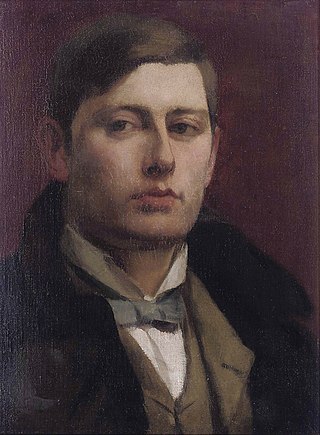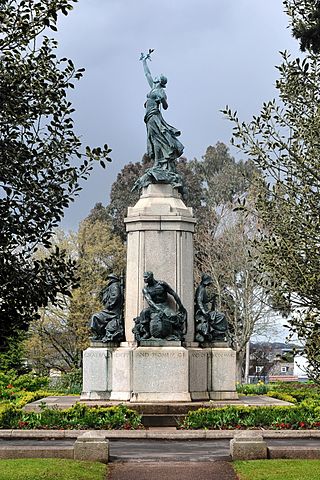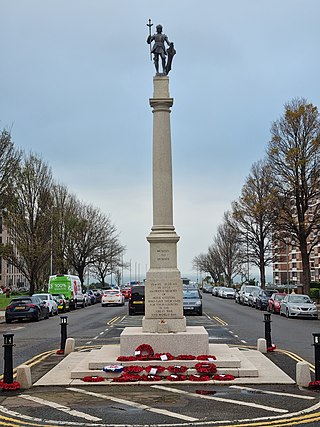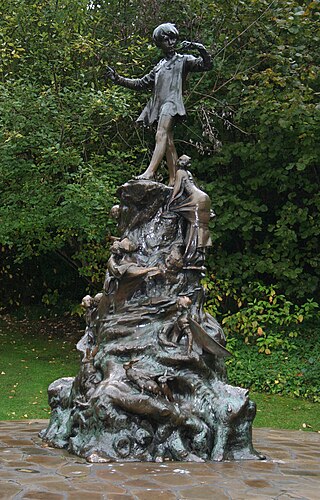
Edith Agnes Kathleen Young, Baroness Kennet, FRBS was a British sculptor. Trained in London and Paris, Scott was a prolific sculptor, notably of portrait heads and busts and also of several larger public monuments. These included a number of war memorials plus statues of her first husband, the Antarctic explorer Captain Robert Falcon Scott. Although the Oxford Dictionary of National Biography describes her as "the most significant and prolific British women sculptor before Barbara Hepworth", her traditional style of sculpture and her hostility to the abstract work of, for example Barbara Hepworth and Henry Moore, has led to a lack of recognition for her artistic achievements.

Sir George James Frampton, was a British sculptor. He was a leading member of the New Sculpture movement in his early career when he created sculptures with elements of Art Nouveau and Symbolism, often combining various materials such as marble and bronze in a single piece. While his later works were more traditional in style, Frampton had a prolific career in which he created many notable public monuments, including several statues of Queen Victoria and later, after World War I, a number of war memorials. These included the Edith Cavell Memorial in London, which, along with the Peter Pan statue in Kensington Gardens are possibly Frampton's best known works.

Alfred Adrian Jones was an English sculptor and painter who specialized in depicting animals, particularly horses. Before becoming a full-time artist he was an army veterinary surgeon for twenty-three years. On retirement from the British Army, Jones established himself as an artist with a studio in London. He became a regular exhibitor at the Royal Academy and in commercial galleries from 1884 onwards. His training as a veterinary surgeon gave him a deep knowledge of equine anatomy which he used in his work to great effect. He created the sculpture Peace descending on the Quadriga of War, on top of the Wellington Arch at Hyde Park Corner in London. Following both the Boer War and World War I, Jones created a number of notable war memorials including the Royal Marines Memorial and the Cavalry of the Empire Memorial, both in central London. Alongside the public monuments he created, Jones made equestrian and equine statuettes and portrait busts. Whilst well known as a sculptor, Jones was also an accomplished painter.

On 2 September 2006, a Royal Air Force Hawker Siddeley Nimrod suffered an in-flight fire and subsequently crashed in Kandahar, Afghanistan, killing all fourteen crew members on board. The crash, which occurred during a reconnaissance flight, was the biggest single loss of life suffered by the British military since the Falklands War.

Sir William Goscombe John was a prolific Welsh sculptor known for his many public memorials. As a sculptor, John developed a distinctive style of his own while respecting classical traditions and forms of sculpture. He gained national attention with statues of eminent Victorians in London and Cardiff and subsequently, after both the Second Boer War and World War I, created a large number of war memorials. These included the two large group works, The Response 1914 in Newcastle upon Tyne and the Port Sunlight War Memorial which are considered the finest sculptural ensembles on any British monument.
Edward Alfred Briscoe Drury was a British architectural sculptor and artist active in the New Sculpture movement. During a long career Drury created a great number of decorative figures such as busts and statuettes plus larger monuments, war memorials, statues of royalty and architectural pieces. During the opening years of the 20th-century he was among the foremost architectural sculptors active in Britain and in that period created the series of works in central London for which he is perhaps now best known. These include the figures on the Old War Office building in Whitehall, elements of the facade of the Victoria and Albert Museum and four of the colossal statues on Vauxhall Bridge.

St James’ Church lies in Warter, an estate village in England, in the Yorkshire Wolds, part of the East Riding of Yorkshire.
Henry Charles Fehr FRBS was a British monumental and architectural sculptor active in the late nineteenth and early twentieth centuries. He produced several notable public sculptures, war memorials and works for civic buildings. These included architectural sculptures for Middlesex Guildhall, for Wakefield County Hall and for Cardiff City Hall. Throughout the 1920s, Fehr created a number of war memorials, often featuring detailed bronze statuary, for British towns and cities. Notable examples of Fehr's war memorials include those at Leeds, Colchester, Keighley and at Burton upon Trent.

The Bromley War Memorial in Bromley, Greater London, England commemorates the fallen of World War I and World War II. It was designed by British sculptor Sydney March, of the March family of artists.

The Bromley Parish Church Memorial commemorates the deceased parishioners of World War I. The war memorial was designed and constructed by British sculptor Sydney March, of the March family of artists.

John Angel was a British-born sculptor, architectural and ecclesiastical sculptor, medallist and lecturer. He emigrated to the United States where he created architectural sculpture. His work in the United Kingdom and the United States has been critically praised.

Exeter War Memorial, also known as The Northernhay War Memorial is a war memorial in Northernhay Gardens in the city of Exeter, Devon. Designed by John Angel, it was erected by public subscription in 1923 and cost over £6,000.

Rochdale Cenotaph is a First World War memorial on the Esplanade in Rochdale, Greater Manchester, in the north west of England. Designed by Sir Edwin Lutyens, it is one of seven memorials in England based on his Cenotaph in London and one of his more ambitious designs. The memorial was unveiled in 1922 and consists of a raised platform bearing Lutyens' characteristic Stone of Remembrance next to a 10-metre (33 ft) pylon topped by an effigy of a recumbent soldier. A set of painted stone flags surrounds the pylon.

Mells War Memorial is a First World War memorial by Sir Edwin Lutyens in the village of Mells in the Mendip Hills of Somerset, south-western England. Unveiled in 1921, the memorial is one of multiple buildings and structures Lutyens designed in Mells. His friendship with two prominent families in the area, the Horners and the Asquiths, led to a series of commissions; among his other works in the village are memorials to two sons—one from each family—killed in the war. Lutyens toured the village with local dignitaries in search of a suitable site for the war memorial, after which he was prompted to remark "all their young men were killed".

Hove War Memorial is a First World War memorial designed by Sir Edwin Lutyens and located on Grand Avenue in Hove, part of the city of Brighton and Hove, on the south coast of England. Hove was the site of one of the earliest recruiting events at the beginning of the war and later of several military hospitals. Over 600 men from the town were killed during the war, a quarter of them from the local regiment alone. A war memorial committee was established in 1919 and Lutyens was engaged as architect. A design was agreed in 1920 after two unsuccessful proposals; Lutyens chose the site from several options.

Croydon Cenotaph is a war memorial, in Croydon, London, England. It is located outside the Croydon Clocktower arts complex, on Katharine Street in Croydon.

The statue of Peter Pan is a 1912 bronze sculpture of J. M. Barrie's character Peter Pan. It was commissioned by Barrie and made by Sir George Frampton. The original statue is displayed in Kensington Gardens in London, to the west of The Long Water, close to Barrie's former home on Bayswater Road. Barrie's stories were inspired in part by the gardens: the statue is at the place where Peter Pan lands in Barrie's 1902 book The Little White Bird after flying out of his nursery. Six other casts made by Frampton have been erected in other places around the world.

King Square in Bridgwater within the English county of Somerset was laid out with large Georgian houses between 1770 and 1800 on the site of Bridgwater Castle. It is also the site of the Bridgwater War Memorial

The City of Portsmouth War Memorial, also referred to as the Guildhall Square War Memorial, is a First World War memorial in Guildhall Square in the centre of Portsmouth, Hampshire, on the south coast of England. Portsmouth was and remains a port and home to a major naval dockyard. The dockyard and the armed forces provided much of the employment in the area in the early 20th century. As such, the town suffered significant losses in the First World War. Planning for a war memorial began shortly after the end of the conflict and a committee was established for the purpose. It selected a site adjacent to a railway embankment close to the Town Hall and chose the architects James Gibson and Walter Gordon, with sculptural elements by Charles Sargeant Jagger, from an open competition.

















